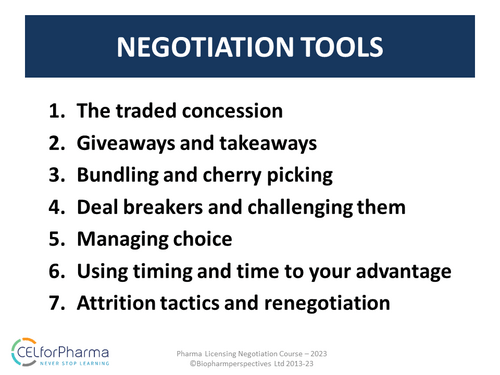Negotiating successful licensing agreements in the pharmaceutical industry requires skill, strategy, and the recognition and effective use of negotiation tools. By recognising when these tools are being used and deploying them appropriately, BD&L managers can navigate complex discussions, respond objectively, address concerns, and achieve favourable outcomes.
In this article, Dr Roger Cox, CELforPharma faculty member for The Pharma Licensing Negotiation Course explores seven powerful negotiation tools utilised in pharma licensing negotiations.

1. The Traded Concession:
The traded concession is a common negotiation tool that involves offering or requesting specific concessions in exchange for desired outcomes. By saying, ‘I will concede this if you will do that’, negotiators create mutually beneficial trade-offs. It is essential to label and make concessions which are contingent on a trade.
2. Giveaways and Takeaways:
This tool appears as a concession but functions differently. Negotiators may sometimes create an apparent problem or issue and then concede it, taking away the problem they initially introduced…as an apparent concession! It is designed to increase leverage but must be used cautiously to avoid losing credibility. Giveaways and takeaways manipulate perception and can be effective if deployed strategically.
3. Bundling and Cherry Picking:
Bundling combines less attractive features with more attractive ones to create an overall attractive bundle or package. Bundles should be carefully analysed to ensure that the less attractive features do not ‘poison’ the whole deal. Conversely, cherry picking involves one party selecting only the most desirable elements of a deal from their point of view. However, accommodating the reasonable expectations of the other party is usually necessary to achieve a long-lasting amicable commercial relationship!
4. Deal Breakers and Challenging Them:
Deal breakers are non-negotiable points of principle. While they can restrict negotiation flexibility, they can still be challenged with empathy and contingent concessions. By proposing alternative solutions that respect the other party's underlying position, negotiators can build a "Golden Bridge" that allows for compromise while saving face. Challenging deal breakers can help to maintain a productive negotiation environment.
5. Managing Choice:
Expanding choice in negotiations moves them beyond a binary ‘yes’ or ‘no’ framework. By presenting options with varying advantages and disadvantages, decision-making becomes more nuanced. Negotiators can offer alternative proposals and engage the other party in finding a mutually beneficial solution. This approach makes it more difficult for the other party to persist with unreasonable demands and facilitates a positive outcome.
6. Using Timing and Time to Your Advantage:
Timing plays a critical role in negotiations. Establishing an agenda and timetable, and gaining acceptance from the other party, helps manage the negotiation process. Negotiators can leverage time constraints to expedite decision-making. Parties' adherence to the agreed timetable reveals their motivation, and if no motivation is evident, it may be time to consider walking away. Careful use of deadlines and timing of communications further enhances negotiation effectiveness.
7. Attrition and Renegotiation:
Attrition, repeatedly emphasizing the same point, can wear down the other party, but it risks damaging the relationship. Sometimes negotiators revisit previously agreed-upon points, seeking to renegotiate them for perceived advantage. However, this tactic may call into question the negotiator's integrity and trigger renegotiation of other topics.
Mastering the art of pharma licensing negotiations requires the ability to recognise and appropriately deploy a repertoire of negotiation tools, enabling negotiators to create win-win situations, build strong relationships, and secure mutually beneficial agreements.
